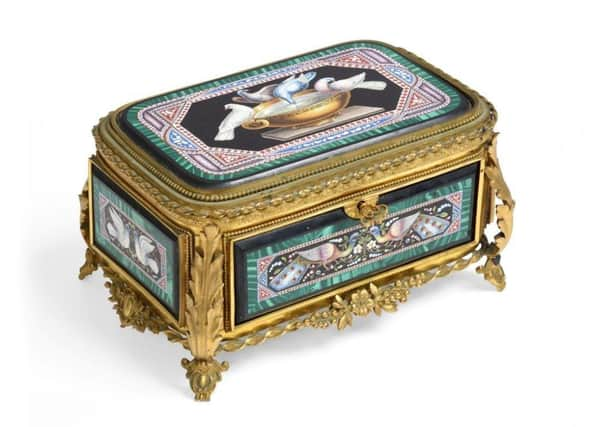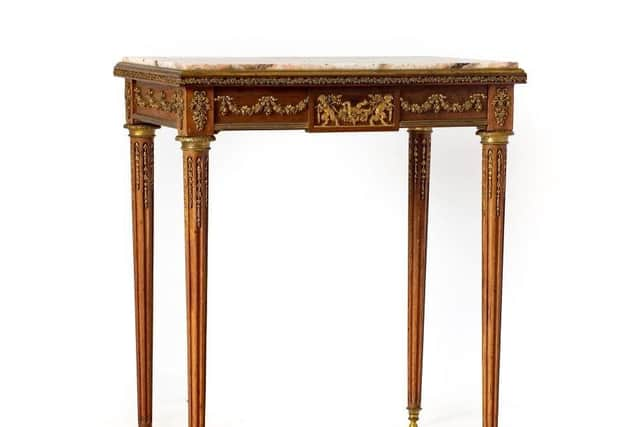Micro-mosaic casket a highlight of Tennants Auctioneers’ Summer Fine Sale


The Italian Gilt Metal and Micro-Mosaic Casket, made in Rome and dating to circa 1860, will be offered with an estimate of £7,000-10,000 (plus buyer’s premium).
The mount is stamped ‘Guttin’. The casket has beautifully wrought peacocks and doves on the four side panels, but the central focus is the cover with its fine depiction of the Doves of Pliny or the Capitoline Doves, one of the most important Italian mosaic motifs. The image of four doves around a water vessel was taken from a 2nd century A.D. mosaic, discovered in the 1730s at Hadrian’s Villa in Tivoli and transferred to the Capitoline Museum in the 1760s. At first believed to be a mosaic described by Pliny, it was actually made after the philosopher’s death and is now thought to have been based on an Ancient Greek mosaic by Sosus of Pergamon.
Advertisement
Hide AdAdvertisement
Hide AdA cut glass gobelet that accompanied Napoleon I whilst on campaign is also on offer with an estimate of £1,000-1,500. Whilst on campaign, Napoleon demanded that he was looked after in the manner to which he was accustomed in the Imperial Palace, surrounded by luxurious goods that befitted his rank and served to the highest standards of formal etiquette. As such, his encampment was equipped with specially commissioned campaign furniture and furnishings, each object of such fine workmanship that many pieces were housed in fitted carrying cases during travel. The present glass was made by Montcenis and is engraved with a ‘N’ topped by the imperial crown. The glass is held in a beautifully made fitted brown leather cylindrical case, with green silk velvet lining and the outside embossed with the same crowned ‘N’ and gilt bees.


Amongst the ceramics and works of art in the sale, further lots of note include a Kangxi Chinese Porcelain Jar and Cover (estimate: £5,000-7,000), an unusual Chinese Porcelain Tea Bowl and Saucer from the mid-18th Century, decorated with the European subject of Diana attending a hunt (estimate: £300-400), a Meiji Period Miyao Bronze Figure of a Craftsman (estimate: £1,500-2,000), and a Bronze Figure of the Muse Harmonie after Albert-Ernest Carrier-Belleuse (estimate: £1,500-2,000).
A French Mahogany Ormolu Mounted Louis XV/Transitional Style Side Table by François Linke, by repute purchased from the Lowther Castle Sale, leads the Fine Furniture in the sale with an estimate of £10,000-15,000. Further good French pieces include a pair of Louis XV/Transitional Style Rosewood, Kingwood, Amaranth and Tulipwood-Banded Vitrines from the late 19th century (estimate: £8,000-12,000). Also of note is a pair of Milanese Neoclassical Walnut and Marquetry-Inlaid Commodes in the manner of Giuseppe Maggiolini, by repute with provenance from Swinton House, Masham (estimate: £4,000-6,000), a 20th Century Mahogany and Ebony-Strung Extending Jupe-Style Dining Table (estimate: £3,000-4,000), and an Japanese Carved Hardwood and Parcel Gilt Shodhana of the Meiji Period (estimate: £3,000-5,000).
To be sold in situ are a selection of fine period chimneypieces from Boston Hall, Boston Spa, North Yorkshire. These include a George III Grey and White Carrara and Yellow Siena Marble Chimneypiece of the late 18th century (estimate: £6,000-8,000), and a Neoclassical Design White Carrara and Yellow Siena Marble Chimneypiece of the early 19th century (estimate: £4,000-6,000).
Advertisement
Hide AdAdvertisement
Hide AdInteresting clocks in the sale are led by a Fine Brass Quarter Chiming Skeleton Clock, made circa 1860 and attributed to either Evans of Handsworth or Smiths of Clerkenwell (estimate: £3,000-4,000). Also on offer are a Mahogany Eight Day Seven Tune Musical Longcase Clock made by William Avenell of Portsmouth circa 1790 (estimate: £3,000-5,000), and a Mahogany Striking Alarm Table Clock made by Chas Broomhall of London circa 1780. A diverse selection of rugs includes a Very Fine Ghom Silk Carpet from Central Iran (estimate: £2,500-3,500).